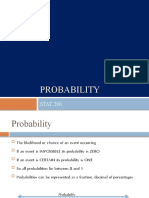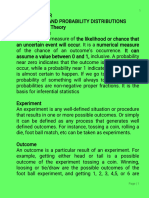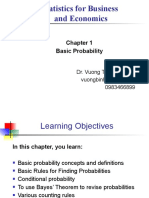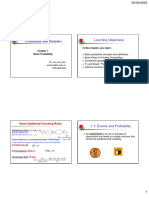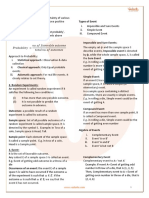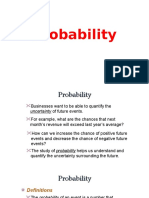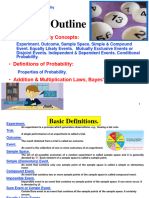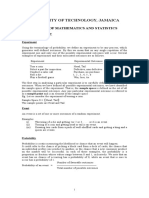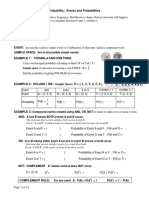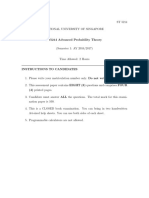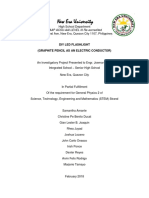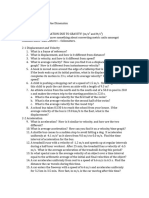INTRODUCTION TO PROBABILITY
Experiments, Outcomes, Events and Sample Spaces
What is probability? Basic Rules of Probability Probabilities of Compound Events
�EXPERIMENTS, OUTCOMES, EVENTS AND SAMPLE SPACES
Experiment: An experiment is any activity from which results are obtained. A random experiment is one in which the outcomes, or results, cannot be predicted with certainty.
�EXPERIMENTS, OUTCOMES, EVENTS AND SAMPLE SPACES
Examples: 1. Flip a coin 2. Flip a coin 3 times 3. Roll a die 4. Draw a SRS of size 50 from a population Trial: A physical action , the result of which cannot be predetermined
�BASIC OUTCOMES AND SAMPLE SPACES
Basic Outcome (o): A possible outcome of the experiment Sample Space: The set of all possible outcomes of an experiment
�BASIC OUTCOMES AND SAMPLE SPACES
Example #1: A company has offices in six cities, San Diego, Los Angeles, San Francisco, Denver, Paris, and London. A new employee will be randomly assigned to work in on of these offices. Outcomes: Sample Space:
�Example #2: A random sample of size two is to be selected from the list of six cities, San Diego, Los Angeles, San Francisco, Denver, Paris, and London.
Outcomes: Sample Space:
�EVENTS AND VENN DIAGRAMS
Events: Collections of basic outcomes from the sample space. We say that an event occurs if any one of the basic outcomes in the event occurs. Venn Diagram: Graphical representation of sample space and events
�EVENTS AND VENN DIAGRAMS
Example #1 (cont.): 1. Let B be the event that the city selected is in the US 2. Let A be the event that the city selected is in California
�Example #2: A random sample of size two is to be selected from the list of six cities, San Diego, Los Angeles, San Francisco, Denver, Paris, and London. Let E be the event that both cities selected are in the US E= Sample Space and Venn Diagram:
�ASSIGNING PROBABILITIES TO EVENTS
Probability of an event P(E): Chance that an event will occur Must lie between 0 and 1 0 implies that the event will not occur 1 implies that the event will occur
�ASSIGNING PROBABILITIES TO EVENTS
Types of Probability: Objective Relative Frequency Approach Equally-likely Approach Subjective
�Relative Frequency Approach: Relative frequency of an event occurring in an infinitely large number of trials
Time Period 1965 1965-1969 1965-1974
Number of Male Live Births 1927.054 9219.202 17857.860
Total Number of Live Births 3760.358 17989.360 34832.050
Relative Frequency of Live Male Birth 0.51247 0.51248 0.51268
�Equally-likely Approach: If an experiment must result in n equally likely outcomes, then each possible outcome must have probability 1/n of occurring. Examples: 1. Roll a fair die 2. Select a SRS of size 2 from a population
�Subjective Probability: A number between 0 and 1 that reflects a persons degree of belief that an event will occur
Example: Predictions for rain
�ODDS
If the odds that an event occurs is a:b, then
a P ( A) ab
Example: If the odds of Came Home winning the Derby are 9:2, what is the subjective probability that he will win?
�PROBABILITIES OF EVENTS
Let A be the event A = {o1,o2,, ok}, where o1, o2, , ok are k different outcomes. Then
P( A) P(o1 ) P(o2 )
P(ok )
�PROBABILITIES OF EVENTS
Problem The number on a license plate is any digit between 0 and 9. What is the probability that the first digit is a 3? What is the probability that the first digit is less than 4?
�PROBABILITIES OF COMPOUND EVENTS
Law of Complements: If A is an event, then the complement of A, denoted by represents the event composed of all basic outcomes in S that do not belong to A.
S
A
�LAW OF COMPLEMENTS
Law of Complements:
P( A) 1 P( A)
Example: If the probability of getting a working computer is 0.7, What is the probability of getting a defective computer?
�UNIONS AND INTERSECTIONS OF TWO EVENTS
Unions of Two Events If A and B are events, then the union of A and B, denoted by A U B, represents the event composed of all basic outcomes in A or B.
�UNIONS AND INTERSECTIONS OF TWO EVENTS
Intersections of Two Events If A and B are events, then the intersection of A and B, denoted by A B, represents the event composed of all basic outcomes in A and B.
�ADDITIVE LAW OF PROBABILITY
Let A and B be two events in a sample space S. The probability of the union of A and B is
P ( A B ) P ( A) P ( B ) P ( A B ).
�USING ADDITIVE LAW OF PROBABILITY
Example: At State U, all first-year students must take chemistry and math. Suppose 15% fail chemistry, 12% fail math, and 5% fail both. Suppose a first-year student is selected at random. What is the probability that student selected failed at least one of the courses?
�MUTUALLY EXCLUSIVE EVENTS
Mutually Exclusive Events: Events that have no basic outcomes in common, or equivalently, their intersection is the empty set. Let A and B be two events in a sample space S. The probability of the union of two mutually exclusive events A and B is P ( A B ) P ( A) P ( B ).
B S
�MULTIPLICATION RULE AND INDEPENDENT EVENTS
Multiplication Rule for Independent Events: Let A and B be two independent events, then
P( A B) P( A) P( B).
�MULTIPLICATION RULE AND INDEPENDENT EVENTS
Examples: Flip a coin twice. What is the probability of observing two heads?
�MULTIPLICATION RULE AND INDEPENDENT EVENTS
Examples: Flip a coin twice. What is the probability of getting a head and then a tail? A tail and then a head? One head?
�MULTIPLICATION RULE AND INDEPENDENT EVENTS
Examples: Three computers are ordered. If the probability of getting a working computer is 0.7, what is the probability that all three are working ?























